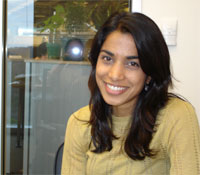CogSci Students Conduct Ethnographic Study of Calit2 at UCSD
By Stephanie Sides
Two students, Monal Chokshi and Will Barley, are applying ethnographic methods in studies of how the Calit2 building at UCSD is being used. Ethnography, one of many methodologies used in the Cognitive Science department, focuses on understanding how people work in their natural environments. Researchers become “participant-observers,” in which they conduct interviews in the context of the specific environments in which individuals work. Among the benefits that derive from this contextual inquiry are that (1) those being observed tend to do things they’re not aware of and might not talk about in an interview away from their workspace, and (2) the observer can ask questions of the person being observed in context, enabling the latter to provide better answers by virtue of being “in the act” at the time.
|
“Ethnography,” said Chokshi, “is not just data collection about what people do. It also helps understand the culture involved in the environment. By that, I mean the social dynamics and interaction that partially structure the environment. These things can be very subtle and are often overlooked.”
Chokshi, a Ph.D. student, will spend this, her third, year reviewing the background literature and studying open issues in this domain so as to identify a more specific research topic and submit a proposal to her thesis committee. For Barley, this work comprises his senior honor’s thesis, which he will present in a seminar to the department (which is open to the public) by the end of spring quarter.
One of the areas Chokshi is interested in is how researchers strive to “stay in control” in their work environments. “How do different kinds of people manage their time, resources, and surrounding environment while constantly being distracted, switching tasks, and doing many tasks at the same time?” she wonders. “Are there differences in the way they attempt to stay in control in open office environments versus closed offices?” One issue is how differing types of work styles, such as those who are “neats” versus those who are “scruffies” (Kirsh, 2001), affect the various strategies, resources, and cognitive artifacts individuals choose to employ to attempt to stay in control.
“I’m most interested in the interruptions people experience while working,” said Chokshi. “Interruptions, as well as other contextual factors, may lead to cognitive overload, so I would like to determine if Calit2 provides the right setting to study such phenomena. Other aspects of the institute that interest me – and that will no doubt help to constrain the topic I finally choose – are that it’s a dynamic, interdisciplinary environment that is highly involved with cutting-edge technology.”
|
Barley’s topic focuses on how the furniture layout and architectural design affect the way people work. He’s interested in the structure of space and how different work environments affect strategies that individuals use to structure and interact with their desktops. Barley will study materials on the participants’ desks, where they place items they use, how they use furniture in different ways, etc. “In essence, I want to understand how they structure their environment to get their jobs done,” said Barley.
Barley is studying two groups, one set in a traditional office with a door (which number about 200 in the building), the other in the open workspace more commonly found at Calit2. He will study participants on the fifth floor, where the Calit2 staff is located. Participants will be asked to explain how they’ve arranged their environments and why, and how they believe that affects their work. After these preliminary interviews, Barley will observe each participant three times for 1-2 hours/session to see how each actually interacts with his or her environment.
Said Barley, “With each participant, I’ll go through the whole space assigned to them, the desk, each drawer, how the office space is laid out. People organize their spaces in ways that make sense to them individually. To understand how a given person works, I need to understand how s/he chose to structure that environment.”
One thing he’ll be looking at, said Barley, is whether the open environment promotes more communication but causes problems due to the relative lack of privacy.
One of the biggest challenges, according to Barley, is “comforting” the people he interviews and getting them to relax. “People think they’re being tested and get self-conscious,” said Barley, “but the focus of my study is observational. It’s not intended to suggest areas for improvement.”
Chokshi said she has a long-standing interest in this field. As a Stanford undergrad, she studied Symbolic Systems, an interdisciplinary major that includes computer science, psychology, linguistics, and philosophy. Her emphasis was on Human-Computer Interaction. After graduating, she spent five years working in the software industry, designing user interfaces and conducting research on users in the field. This experience with collaborative office environments brought her naturally to Calit2.
Barley, by contrast, literally “grew up” in the field. His father is a professor in Management Science and Engineering, coincidentally also at Stanford, studying the ethnography of technology. Barley came to formally study this discipline through an epiphany: He was fascinated with some of the ideas he was learning about in a Cognitive Science class taught by Jim Hollan, and during that period had an unfortunate work experience that focused his attention on the importance of effective user interfaces. He realized that an ethnographic approach was the only viable way to learn how people interact with the real world. “Watching people in lab settings,” he said, “is artificial. You can’t determine their natural practices when they’re removed from where they really work.”
Both students are advised by David Kirsh, a professor in the Cognitive Science department.
For more information, see the Kirsh research group’s website: adrenaline.ucsd.edu.



